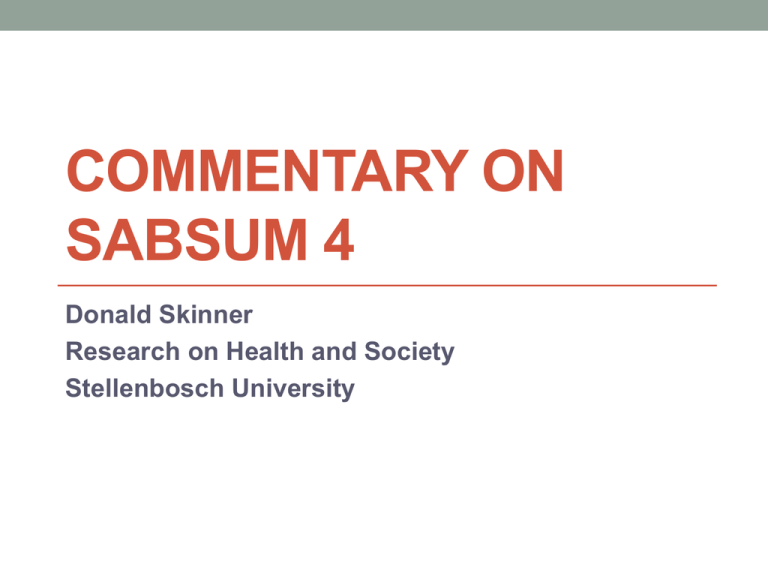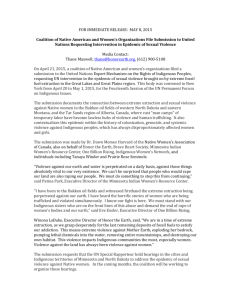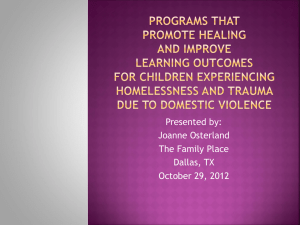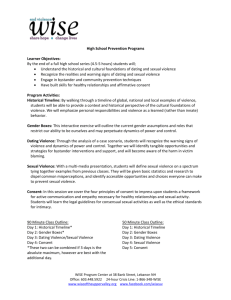
COMMENTARY ON
SABSUM 4
Donald Skinner
Research on Health and Society
Stellenbosch University
• The SABSUM reports are always key points at which to
consider the growth and direction of the epidemic in South
Africa.
• This particular survey report comes at a point where
incidence appears to be reducing generally.
• This is also a point at which ARVs have become more
generally available, so prevalence levels remain very
high.
• Our role is to highlight issues that we felt were important
to us that were highlighted in the results.
Epidemic in the Coloured
population
• In our research among Coloured people attending
shebeens and taverns, and amongst those using tik \
methamphetamine we have been finding increasing levels
of HIV.
• In the community where our research is, clinic nurses
reported at least one person a day testing positive
amongst local Coloured community.
• Western Cape DoH person reported higher levels of HIV+
results amongst young women and older men amongst
those presenting for testing in the clinics.
• The latter two points were felt to be new and increasing
over time. But this is not scientific and no formal review of
the clinic stats has been done.
SABSUM 4 data
2005
2008
2012
0.6
0.3
0.3
Indian/
1.6
Asian
Coloured 1.9
0.3
0.6
1.7
3.1
Black/
African
13.6
15.0
White
13.3
• This trend is supported in the ante natal data.
• Although change still within the confidence limits, it is
•
•
•
•
concerning.
There are areas of concern around risk which appear to
be increasing.
High and increasing levels of substance use.
Alcohol use is very high, and from our research appears
to be increasing amongst women.
Tik \ methamphetamine use high in both men and women.
• High levels of gender violence, domestic violence, sexual
violence and child abuse.
• Generally high levels of community violence and gang
activity.
• High levels of stigma in the Coloured community. AIDS is
seen as a Black African disease. So it remains hidden.
• The myth also reduces the need for protection behaviour.
Age gender distribution of infection
• The pattern remains of women getting infected younger,
from 18 to 25; and men older from 35 up.
• While the emphasis on cross generational relationships is
important I do feel that other important considerations
need greater attention.
Gender violence
• The impact of gender violence especially sexual violence,
as a means of transmission and as a systematic way of
breaking down young women so that they cease to
protect themselves.
• This stems from existing constructs of power and ideas
around masculinity.
• Dangerous as men feel invulnerable, and women feel
disempowered, worthless and damaged.
• Reduces the felt need to use condoms or to stick to one
partner.
Substance use
• Substance use and the risky sexual practices that are
•
•
•
•
associated with it, including sexual exchange and lack of
capacity to stay safe when under the influence.
Sexual exchange is formal and informal sex work, and
direct exchange for alcohol or drugs.
Underage girls are starting to use substances and they
are even more vulnerable.
For women loss of power in sex exchange and
intoxication makes it harder to use condoms.
These may also explain why older men are getting
infected as they are most often the customers.
Opportunities for protection strategies
are being missed
• Legalisation of sex work, so that these women and men
•
•
•
•
•
can be protected.
Decriminalising of certain drugs and offering better
rehabilitation
Intervening in a more consistent and high profile way to
reduce gender violence.
Less tolerance of people who do commit these offenses
or make light of gender violence
Concerns around the impact of traditional legal systems
on women’s rights
Need to raise awareness in the Coloured community
about the potential for the epidemic to rise in this group












